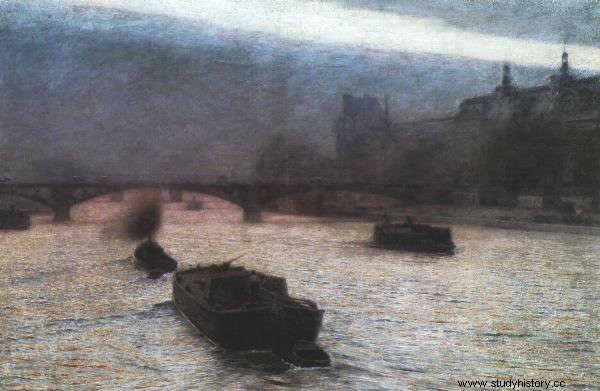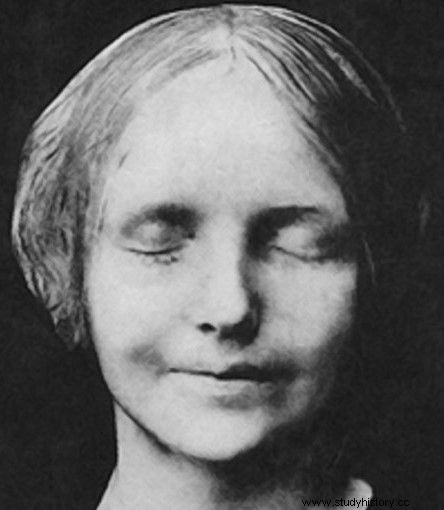The smile evokes our positive associations, but this particular one caused anxiety. No wonder since he belonged to someone who committed suicide a moment earlier.
At the end of the 19th century, Parisians strolled along the lazy Seine as they do every day. They enjoyed the bewitching view of the boulevards, stretched their tired bones while relaxing for a stroll. However, near the Louvre, the body of a young woman was fished from the river and transported to the city morgue near the Notre-Dame Cathedral. Who was this mystery girl and why have we almost all seen her before?
Exhibition of the corpse
The girl's body was not damaged by the decomposition process and no wounds were noticed. She looked as if she had just fallen asleep and was about to wake up. This impression was intensified by a smile - delicate and mysterious.
Since the body was in such good condition, it was assumed that the young woman must have died recently by committing suicide. The body of the stranger from the Seine was taken by pathologists, and the witnesses of this event probably continued to discuss the situation.

Evening on the Seine II
An examination of the body was started in the morgue, but it did not identify the deceased.
According to the common version of events, it was the Parisian doctor who performed the autopsy who made the plaster cast of the girl's face. He found her smile mesmerizingly beautiful. Another story is about a practicing pathologist who was supposed to fall in love with a stranger and as a souvenir - to be able to remember her - he was to make a cast of her face. The truth is, we don't know why such a casting was made at all . Of course, there were many more rumors and people began to wonder who this late beauty was.
There were special windows in the morgue building where unidentified bodies were exposed to the public . The heroine of the text was also found on such a website. The idea of showing the bodies of unrecognized people, strange though today, used to be the only means of identification. People would come to the morgue building to see a corpse that might have belonged to family members or friends. It was also a form of entertainment at the time.

The stranger from the Seine was smiling mysteriously
Society slowly became fascinated by a young, beautiful woman who probably committed suicide by drowning in the Seine. There were conjectures about the reasons for taking his own life - family problems, illness, and perhaps unhappy love. The last theme was especially popular.
Mask of death
The images of the famous plaster cast began to emerge quickly. Sales have also started. Anyone could buy it, although it most often appeared in the studios of artists - painters and sculptors, as well as writers and poets. The fame of the casting even reached Germany.
The first book on the posthumous mask of this woman was written in England and is entitled "The Lover of the Image". It was written by Richard Le Gallienne in 1900. It tells about a young poet who closes himself in a room with a mask and wants it to open his eyes ...
The image of the girl became very fashionable in the 20th century. He was promoted by artists and philosophers. One of them - Maurice Blanchot - had a mask in his home on the Côte d'Azur and believed that at the time of her death she had experienced incredible and tremendous happiness.
She was officially called "L'Inconnue de la Seine", a stranger from the Seine . We can see her face even in Warsaw above the entrance to the tenement house at ul. Śniadeckich 23. She became an inspiration for, for example, Vladimir Nabokov in the creation of "Lolita" and for Stanisław Grochowiak, who wrote a poem about her entitled "The Stranger from the Seine" (collection "Knight's Ballade"):
(…) that you dragged your body through the boulevards,
Tightened with a slimy last dress -
And nobody wanted you. From that victim
You only realized that you were still a child.
That gentle smile that craves
A crumb of love, you were thinking in the Seine,
And there was only a second Giaconda left,
And only an empty question was left.
Kissing the drowned man
We don't realize that we almost all know this young woman. Most have probably touched their lips to hers. But one by one…

Phantom Anne
Asmund Laerdal (Norwegian mannequin builder) together with two doctors - James Elam and Peter Safar - created a phantom for learning CPR in 1960. Choosing a face for the resulting modern mannequin turned out to be a big problem. The death mask of a deceased woman fished out of the Seine was helpful . She was given the name Anne. It can be said that Laerdal wanted to symbolically render the phantom the human features of the person who lost his life. The mannequin became popular, more and more people learned on it how to save lives during first aid. You, dear readers, probably also.
